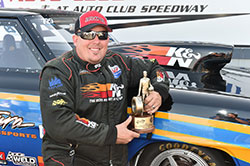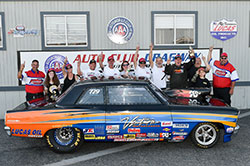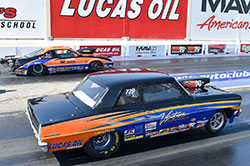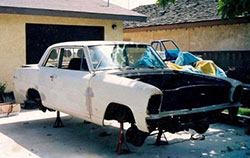Big Change, Bigger Results for Drag Racer and K&N Employee Greg Ventura
- 17 Aug 2016
Drag racing is not a sport or pastime. It’s a lifestyle. And for K&N maintenance analyst Greg Ventura, it has been a lifelong passion shared with his father Al. It culminated earlier this year, when Greg went seven rounds to win the Super Street class at the NHRA Lucas Oil Series race at Auto Club Raceway, in Fontana, California.
Making the win all the more poignant was the fact Greg – at the ripe-old age of 42 – did it in the 1966 Chevy II that he’s had since high school. He and his father built the car way back in 1993 and for the next 21 years, despite a number of changes and updates, it ripped the strip with a high-winding, high-compression small block. That came to an end in 2014, when Greg admitted the fun factor with the car had diminished. “To be honest, the car hadn’t run since 2011 and my father, Al Ventura, passed away the following year. I thought I was pretty much at the end of the line with the car,” he says. “But during lunch with fellow K&N employee Kevin McClelland, who raced in the same class, he suggested changing up the combination in a big way – with a big-block engine on pump gas.” Rather than high-rpm horsepower to pull the vintage Nova down the track, the idea was to rely on the big-hammer adage that there’s no replacement for displacement. The torque of a big-inch big block would not only provide a wheel-lifting shove for the featherweight Chevy, but do so at comparatively low rpm. “Kevin’s suggestion was that big torque and low rpm with translate into great performance and lower maintenance than the high-rpm small block,” says Greg. “Great longevity and lower maintenance sounded great to me – and I hadn’t run a big block, so it all sounded like a good way to rejuvenate my racing program and enthusiasm.” Greg admits it’s an idea his father floated way back in 1997. “Yes, but the kid who knew everything didn’t want to hear it,” he says. “I was afraid of sacrificing performance, so I didn’t pursue it.” More than 15 years later, he had a 568-cubic-inch engine built, using a lightweight BRODIX aluminum cylinder block and BRODIX aluminum heads, offsetting what would have been a pretty drastic weight balance change for the car.
“I wanted the changeover to be a 100-percent-correct update, with excellent attention to detail to make sure everything fit correctly and cleanly,” says Greg. “It was a challenge, but the results were ultimately worth it.” Not surprisingly, the new engine required a new set of custom headers, a new motor plate and even modifying the existing hood scoop to accommodate the big block and K&N E-1500 with XStream top filter that Greg runs. That isn’t the only K&N product he runs though. He also uses a 62-1513 crankcase filter, HP-3002 oil filter, and 81-1005 fuel filter. The work consumed Greg’s spare time from the fall of 2014 to the spring of 2016. A year later, he collected the trophy in Fontana. It was Greg’s first outing with the car since the engine change, affirming the decision to make the change and reinforcing that rejuvenated feeling of getting behind the wheel again of a race car he’s worked with for just about a quarter of a century. It also validated the idea his father offered nearly two decades earlier. “It was very satisfying to roll out there and come away with a win at the very first race,” he says. “I felt like I had a brand-new car and I had a blast.” Greg’s dad Al would certainly have approved – and maybe said, “I told you so.” Acknowledgements: Greg thanks Kevin McClelland, K&N, Tom Bogner at Lucas Oil Products, Tom Capalbo from Taylor Freezers, Jimmy from Race Trans, the guys at Brodix, Keith from Total Seal Piston Rings, Aeromotive Fuel Systems, Darryl Duncan and Jason Swift at Goodyear Racing Tires, as well as Kevin Drew for getting the suspension and chassis ironed out and Jack Derencin for helping make a big block fit where a small block used to. He also sends special thanks to his wife Adriana and his mom, Connie Ventura. |
||||
|
||||













